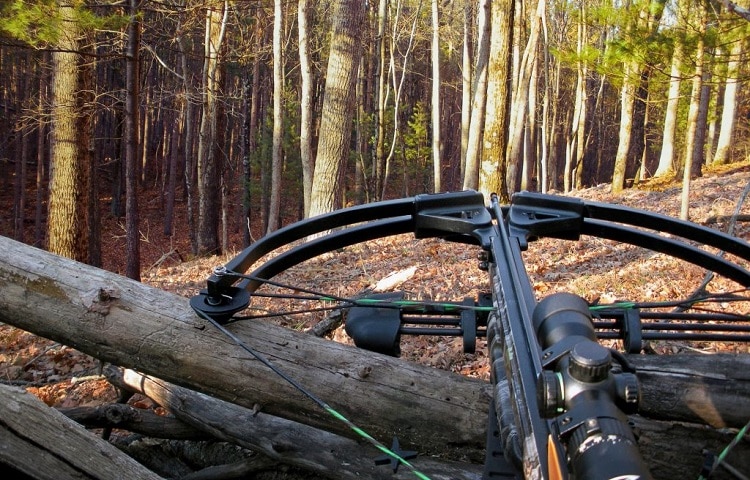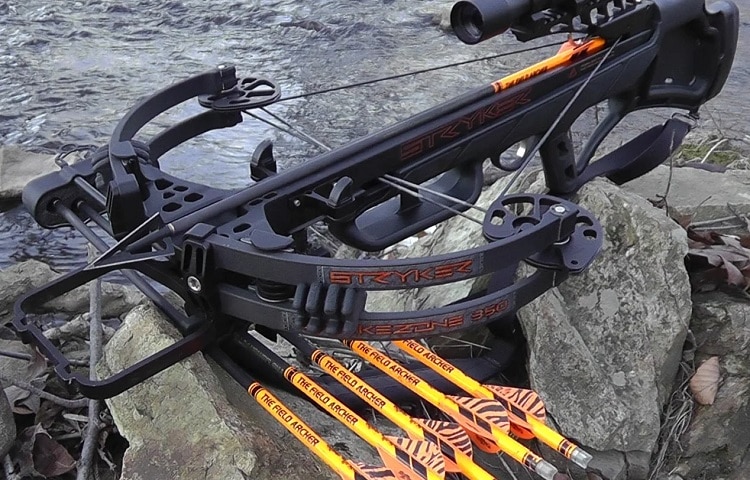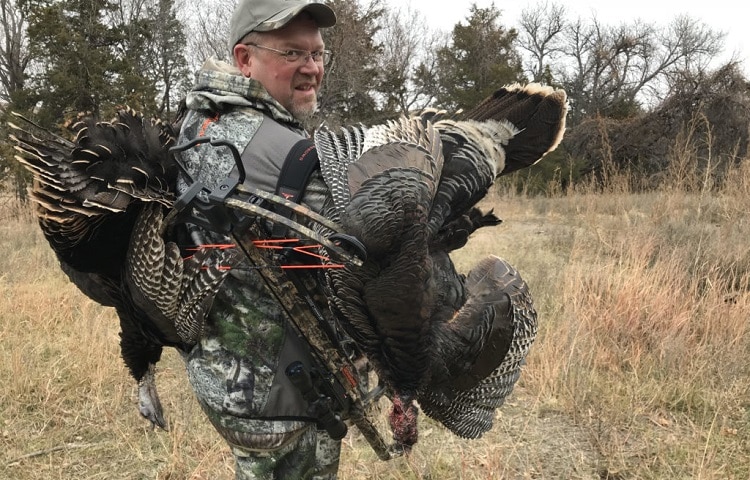The crossbow effective range depends most on skill, but it also has a ton to do with mechanics, maximum draw weight, FPS, wind speed, direction, bolt weight, and more.
Yeah, there’s a lot to cover, but I’ll do my best to keep it compact in this brief guide.
What Affects How Far a Crossbow Bolt Travels?

More than you might imagine. There are a lot of contributing factors and independent variables that we’ll go over right now.
Air Resistance
Depending on the wind speed and direction, your bolt could be slowed down by a moderate 10-20 FPS, or up to 50 FPS if conditions are bad enough.
Air resistance occurs no matter what. Unless you’re shooting in a vacuum, you’ll have air resistance. The only input that you really have is how much.
Understand how and where wind travels. In hunting, the ideal position is to get height on your prey, which is when you run into anabatic wind combating you. By the Encyclopedia Britannica’s definition, anabatic wind is:
“Anabatic wind, also called upslope wind, local air current that blows up a hill or mountain slope facing the Sun. During the day, the Sun heats such a slope (and the air over it) faster than it does the adjacent atmosphere over a valley or a plain at the same altitude.
This warming decreases the density of the air, causing it to rise. More air rises from below to replace it, producing a wind. An anabatic wind often attains a velocity of 3–5 metres per second (7–11 miles per hour).”
You’ll have the high ground more often than not during hunting. The only real exception to this would be shooting from a treestand, because the distance is so short and it doesn’t react the same way that a hilltop or major height difference will.
Draw Weight

Draw weight is something you’ll notice when you buy a crossbow. They’re usually separated by draw weight because it equates to a form of power. The higher the draw weight, the more pressure holds back the bolt, which can result in better FPS, or frames per second.
You need a certain draw weight to even hunt with a crossbow in the first place, because beneath a certain threshold, it will just harm or maim an animal instead of killing it.
That’s just one way that we measure a crossbow’s power, because without draw weight, you can’t get past a certain FPS.
FPS
This stands for feet per second, which is basically how fast your bolt is travelling from the crossbow.
The difficult thing is that you can’t perfectly dictate FPS because it depends on the crossbow itself, but it also depends on the ammunition. We’ll talk more about bolts in a minute, though.
Your FPS and draw weight work together, or they hinder each other. Heavy bolts may mess with your draw weight, but a bad string can also hinder your FPS. Because the FPS is affected by so many things, you can’t really say “This crossbow had bad FPS” without first making sure every other working part is top-notch.
Weight and Shape of the Bolt
The heavier the bolt (usually measured in grains just like arrows), the more drag it’s going to have going through the air.
Every millimeter that the bolt travels will be that many grains harder, and it adds up quickly. While we have to have some amount of weight so that the object doesn’t stop travelling through the air, there’s a balance.
You’ll find that this is something that manufacturers manipulate more often than any other attribute for bolts.
They’ll mention that they are able to increase your FPS and make more of your draw weight, and while some of these claims are true, they know this is where the main pain point is for crossbow hunters: everyone wants faster, stronger crossbow bolts.
Don’t get roped into the marketing jargon. It comes down to shape for aerodynamics, and the weight of each individual bolt.
Effective Target Range is Different From Travel Distance

If you see crossbows that say they can drive a bolt over 1,500 feet, that may be true.
Most modern crossbows with over 300 FPS and at least 70 lbs of draw weight can make your crossbow bolt disappear in an instant, landing 500+ yards away before it loses momentum and falls from the air.
Momentum. That’s the key here. An effective range is different from the travel distance because at a certain distance, your bolt isn’t going to be able to actually kill a deer, or anything for that matter. As it travels, it loses power.
Calculating momentum is a tricky bit of business. It can help you better understand how your bolts will travel, but we’re not trying to become an Olympic bowhunter—we’re just trying to land a kill during hunting.
Keep your shots within the effective range guidelines that we’re going to put in the next section and you’ll do alright.
Game Size and Effective Range
The size of your target, the thickness of their hide, and how dense they usually are will all play into your crossbow’s effectiveness.
We know that air resistance, bolt weight, shape, and so many more factors affect how our shots land, but let’s assume that we’re firing at about 80% efficiency just for the sake of argument. These are the effective ranges you should be from a target before even considering taking them down.
- Whitetail Deer: Whitetail can range from 100 lbs to 150 lbs depending on gender and what season you’re hunting them in. This makes them relatively easy targets to take down with a crossbow. You should be between 30 and 40 yards away from them with an 80 lb draw weight and 300+ FPS.
- Moose: Moose can range from a low 440 lbs for females, up to a staggering 1,500 lbs in males depending on the season. That’s literally ten times the peak size of a male whitetail in summer. They’re big beasts to take down, but they’re also aggressive, so we want a balance of range and power. You should hunt between 40 yards and 60 yards away. Over 60 yards, you may see a dip in performance, but even in that 40-60 range you’ll likely need a second bolt to take down a fully grown moose anyway. Caution is advised.
- Bear: If you’re trophy hunting for that niec new pelt for the cabin floor, more power to you. North American brown bears can range from about 180 lbs (usually cubs) up to an impressive 1,300 lbs. Just like with moose, you should be up to 60 yards away, and expect to fire a second bolt to finish taking it down.
- Rabbits: While an 80 lb draw weight crossbow may be overkill here, you can also get away with a pistol crossbow if you want. You can successfully take down a rabbit from 100+ yards away, as long as your aim is good enough.
As a rule of thumb, any game that is as big as you are or larger should be shot from no closer than 40 yards away. That’s the magic number.
Exercise caution when going up against potentially aggressive game, because if you miss that shot with the bolt or you don’t deliver a killing shot, you’re in for a rough ride.
Are Crossbows Long Range Weapons?

No, not really. Medium-range at best.
If you had a compound bow with the same draw weight and FPS capability as a crossbow, and for all intents and purposes it is the same in terms of specs, you wouldn’t consider a compound bow to be a long range weapon.
The best way to look at where crossbows reside in terms of ranged power is by taking a gander at F-class shooting. F-class is long range, and operates in the range of 300 to 1,200 yards, or 900 to 3,600 feet.
Crossbows are not effective at 300 yards, although they’d still hurt a target under the right conditions, they may lose their lethality.
I’m not saying that your crossbow couldn’t hit the target from 300 yards away, but anything over 100 yards is when you run into issues with momentum.
If you pay attention to the previous section, 40 yards is the maximum distance we really want you from a whitetail if you want to deliver a killing blow in one shot. You can shoot them from up to 100 yards away, but it’s not advised.
Fine-Tuning Every Shot
If you’re not currently performing as well as you want to, change your bolts, go for lower grain weights and better shapes.
Consider the range of your crossbow, if you’re shooting from too far away, and don’t forget about how much wind can seriously impact your shot.
It’s time to look at your next hunting trip through a different lens. Now that you know what your crossbow can and can’t do, close the gap between you and that next whitetail, and you’ll land a better shot next time around.


